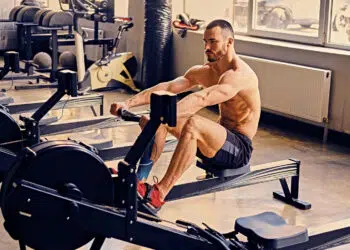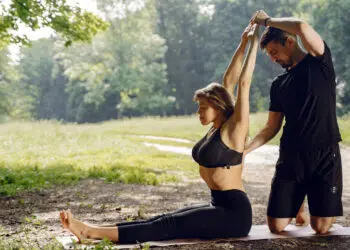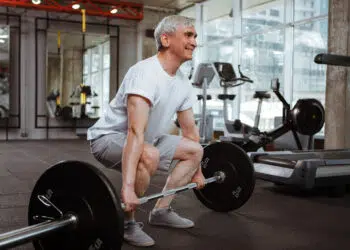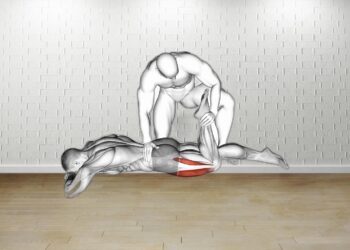After searching high and low, comparing techniques, and spending hours learning hip anatomy, it’s clear that most experts (I’ll toss my pedigree in there as well) would agree the kneeling hip flexor stretch is the superior overall inner thigh and groin exercise.
Not because it’s the best for every hip situation. But rather it’s convenient, beginner-friendly, safe, bodyweight-only (No tools or equipment needed), and most importantly hits the right spot (Those crucial flexors) so well.
The thighs and hips are such a large a powerful complex of muscles that we’d rank them at the atop the list of most important body parts for well-being, physical performance, longevity, and general day-to-day movement.
Walking, squatting, bending down, running, getting in and out of bed, all heavily depend on healthy hip bending ability.
It’s important to mention, however, that we don’t think everyone is walking around with tight and painful crotches like they just finished a leg day marathon. In fact, your hips may be weaker than they are tight.
So this guide is both useful for general hip flexor maintenance, those who are experiencing signs of a tense groin area, and learning the difference between weak and tense muscles.
Level Up Your Fitness: Join our 💪 strong community in Fitness Volt Newsletter. Get daily inspiration, expert-backed workouts, nutrition tips, the latest in strength sports, and the support you need to reach your goals. Subscribe for free!
Well, we’re excited about this one so let’s jump in!
How To Do The Kneeling Hip Flexor Stretch
A rather basic technique, there’s no reason most people cannot do this hip flexor stretch variation. It’s non-intimidating, requires nothing other than a cushioned place for your knees, and also helps improve balance.
You’ll find simple step-by-step instructions, plus a shorter and more in-depth video demonstration of the hip flexor stretch below.
Steps
- Find a soft surface or place a mat/cushioned object (E.g., exercise mat, foam, pillow, etc) on the floor for comfort.
- Carefully get down on both knees in a tall sitting/kneeling position.
- Then bring one of your legs forward and place your foot flat on the floor in front of you. This is the same position when you drop down into a lunge.
- Keep your body upright, not leaning forward or back.
- Gently push your hips forward until you achieve the desired stretch in your rear leg hip muscles. Tuck your tailbone and create a posterior pelvic tilt to enhance the stretch in your psoas muscles.
- Hold this pose for 5 seconds, shift back to the starting position, then repeat 2-4 more times on one side then switch legs and do the same.
Pro Tips
- You can take a muscle beyond its normal limits, placing lots of pressure on the joints and fascial tissue that surrounds and intertwines in the muscles, which could cause injuries. If you feel sharp pains or an awkward feeling stop immediately. You’re going too hard. Another indicator of overstretching is feeling sore the next day, not to be mistaken with delayed onset muscle soreness after a resistance training session.
- Unless prescribed by a medical professional, avoid excessive hip flexor stretching. There’s a point of diminishing returns. Sometimes hip flexors need strengthening more than stretching. Learn more in the faqs section towards the end of this guide.
Muscles Worked During The Hip Flexor Stretch
As the name implies, your objective will be to emphasize the muscles that allow you to bend at the hip or thigh.
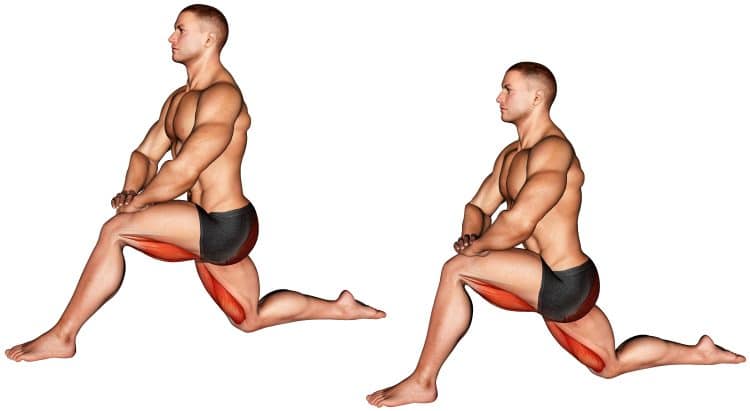
Hip flexors
Several muscles help flex the hips but a forward-moving exercise like hip flexor stretch primarily targets the iliopsoas, which is the largest and most powerful. Iliopsoas are actually two muscles, psoas major and iliacus.
Separated in the abdomen and conjoined in the thigh, iliopsoas can function individually or as a duo to stabilize and movement the hip region.
Psoas also attaches to vertebrae and into the thoracic spine laterally, therefore, it also contributes to side bending motions, even without moving the legs.
Consequently, tight hip flexors can cause compression of the spine and back pain as a result. Adiditonally, you may feel the consequences of tight flexors in your glutes and neck too (1).
When stretching the hip flexors, you need to include both hip flexion, and trunk bending which we’ll show you with a stretch and mobility drill under the variations and alternatives category later in this guide.
In This Exercise
- Target muscle group: Iliopsoas
- Type: Stretch
- Mechanics: Isolation
- Equipment: Exercise mat or cushioned floor
- Difficulty: Beginner
Benefits of The Kneeling Hip Flexor Stretch
The hips are an important muscle for well-being, and longevity. We can assure you that regular stretching sessions will help maintain the integrity of this crucial joint. These are all the reasons why you should be focusing on your iliopsoas regularly.
Reinforce your athletic prowess and outlast the competition
You can kiss your athletic and performance potential goodbye without a strong and mobile hip complex. That also includes your powerful glutes that work with the hips to move your body.
While stretching doesn’t directly increase muscle mass or strength and power output, it does create a healthy, more spacious (Stretching out the surrounding fascia) and efficient environment to support your gains and performance!
When your hip flexors are pliable, they can contract with maximal force, subsequently allowing the joints to move through their full range of motion. And that’s how you get peak athletic performance.
Again, don’t skip over the hip mobility and stretch combo drill under variations sections below if you want to stay active, and be as competitive as possible.
Extend your prime
It’s a metaphorical use of the term prime but oftentimes our lifestyle choices age our bodies faster than they otherwise would.
One example is when you see a fit elderly person who works out and exercises. They walk with a pep in their step, and have what most would agree is a very good quality of life. But then there are others in a similar age bracket who are not as physically active and it affects the body’s structure long term.
Just like a car, house, etc, you have to do regular maintainence if you want something to last and keep giving to an acceptable level of satisfaction.
Well, the body is no different. To add on top of that, our modern lifestyles don’t help when we’re no doubt becoming more sedentary as a culture overall. Sure we’re also more encouraged to get up and be more active, but remote work, and devices get so much priority.
The takeaway here is stretching keeps the muscles long, healthy, functional, and less prone to injuries.
Stretching also helps with proper body alignment and consequently, maintaining essential human movement patterns like coordination and balance.
It’s also important to note that you can’t abuse your body and expect to be problem free years down the line. Sometimes your career or hobbies depend on it, but be sure to take plenty of rest days, stretch, and treat your body well.
Reverse your modern butt syndrome
If you only read the subheader, take a second to guess what it implies. Yep, if you thought modern butt syndrome means sitting on your heinie all day then you’re right.
What’s so bad about that?
Well, when you sit too long, the flexed leg position shortens the muscles in your hips and lower body. This affects posture, range of motion, and can cause pain both in the hips and lower back.
Level Up Your Fitness: Join our 💪 strong community in Fitness Volt Newsletter. Get daily inspiration, expert-backed workouts, nutrition tips, the latest in strength sports, and the support you need to reach your goals. Subscribe for free!
Getting in a lunge pose aka hip flexor stretch will reverse the seated position, lengthen the iliopsoas fibers, and bring flexibility back to the muscle.
Common Mistakes During The Kneeling Hip Flexor Stretch
Learn the dont’s of this mega effective hip complex stretch.
Leaning forward or back
You might see others leaning back or forward in a hip stretch, but we’d like you to remain straight with a vertical torso. We feel this allows you to have better control, and awareness to ensure you’re stretching both sides symmetrically.
Being too aggressive
Our muscles are quite resilient, however, sometimes you can never predict when they’ve had enough. It’s better to be safe than sorry, and have patience as your muscles open up when they’re ready.
Hyperextending your lower back
This one is sort of the previous two common mistakes melded together. Because if you’re pushing the hips too far forward and aggressively, it can hyperextend your lower back.
This can cause problems to the bones, vertebrae, and nerves in the lower back region.
Doing too much
Before you begin stretching your hip flexors, first determine why you need to stretch them, the extent of your tightness, and then you’ll have a better idea of how frequently or how long to hold your stretches.
We can’t prescribe the perfect stretching regime for everyone as we don’t know your situation.
But if you can do physical activities comfortably without pain, safe to say you’re hips are good. But if you have pain walking, and climbing or training, you’ll need to address the problem.
Thankfully there are self tests that you can do to find the problem, or you can visit a medical specialist if you’re not sure why you’re experiencing hip discomfort.
4 Variations and Alternatives of Kneeling Hip Flexor Stretch
You don’t need a large assortment of hip flexor stretches… but we understand that certain variations and body positions feel better for some people. Plus, you may get bored of doing the same old routine and these alternative hip flexor stretches will add plenty of flavor to your iliac stretching rotation.
Hip stretch and mobility drill
This next variation is a genius hip flexor stretch and mobility drill in one single movement, all while keeping your feet in one sport through the entire technique. It also adds a fun element, and if you like doing the limbo you’ll probably dig this exercise.
Unique from any basic psoas stretch, this one incorporates trunk bending to stretch where the hip muscle fibers are attached to the spine.
And, well, it’s no surprise we stole this one from Jeff Cavaliere, MSPT, CSCS, and founder of top fitness YouTube channel Athlean X.
Below we included a step-by-step technique breakdown of this variation, and the original video tutorial by Cavaliere.
Steps
- Set up a smith machine bar roughly level with the top of your hipbone when you’re standing next to it.
- Then stand with the right side of your body to the bar, feet roughly shoulder-width apart. Hinge forward at your hips, and bend your knees while keeping your back straight. Your feet should point toward the end of the bar.
- With your right foot, step to the right under the bar but don’t move your left foot.
- Dip your body and head down right under the bar, then shift your body all the way to the right, and rotate everything from head to toe in the same direction. You should now be in a lunge pose with your back facing the bar. Keep your feet planted on the floor. Do not bend your neck sideways as you dip down. Keep the neck straight.
- Raise your arms overhead and bend your upper body to the right for a left side psoas stretch.
- Then gently drop your butt down to increase the stretch in your hips.
- Now, rotate your body back toward the same starting position, shift and rotate to the left side, pivot your feet, and drop down into the stretch.
- Raise your arms up and bend your torso to the left for a right side psoas stretch.
Watch the full tutorial on this drill below, or skip to the 2:04 mark for the exercise demonstration.
Kneeling couch stretch
More of a double whammy that stretches both the quadriceps and hip flexors, the rear foot is propped up on a couch cushion or similar object to elevate the back leg and stretch the hips with a different technique.
You may notice a more intense or focused stretch with this variation.
The couch stretch can also be performed with the leg behind you and shin against a wall, ankles over knees.
Side plank clamshells
Trying all the hip flexor stretches but still feeling pain and tightness? You may have an imbalance in the butt muscles, glute maximus and medius.
Your glutes are part of the hips, and they’re affected by too much sitting, poor or improper activation, left/right asymmetry, and a number of factors.
If your tooshie is weak or unstable it can cause coordination issues in the hips, and hence you won’t get relief from stretching alone.
Clamshells are the perfect unilateral isolation butt exercise to address the asymmetry.
Here’s a full guide to clamshells.
Yoga based hip flexor stretches
If you practice yoga, well, there are many built in hip flexor stretches that you can do to open up the lower body, and welcome many other benefits. Here are ones that we recommend.
- Lunge pose (Similar position as kneeling hip flexor stretch)
- Bridge pose (Hip bridge)
- Bow pose
- Camel pose
- Dancer pose
Related: Bikram yoga: A hot yoga guide
FAQ’s
How to tell if my hips are tight or just weak?
There are actually tests that you can do on yourself to determine if you have tight or weak hip flexors, which we included in this link for your convenience.
As previously mentioned in our pro tips section, you may need to build strength in your flexors rather than mistake weakness for tightness.
If you know your body, you can simply determine the difference by looking at the possible causes and your habits.
What's causing the tightness in my hip flexors, and what symptoms will I have?
Sitting for hours without a break, little to no exercise, poor posture, uneven sitting positions, muscle imbalances, overuse, a weak core are all causes of tight hip flexors.
You can assess whether your hips are tight with the Thomas test, which is linked in the first faq, and bodily pain is usually another indicator.
Is it possible to stretch your hip flexors too long?
According to a scientific review from 2021, the hip flexors are more resilient than other muscles when it comes to retaining force production after longer bouts of stretching (1).
The study showed that you could stretch the flexors for up to 120 seconds in a single bout and benefit from enhanced performance.
But, in most cases, a good rule of thumb for beginners is to stretch until you feel moderate tension or pulling on the muscles. Then hold it for 10-20 seconds, release, then repeat one to two more times.
As you become more experienced and in tune with your body, you can gradually open up more. Still, never overdo it.
Stretching is not improving my tight hips, what should I do?
You may have instability in the glute maximus and medius, and you can fix this issue with side plank clamshells which you can find above under the variations and alternatives part of the article.
You can also use a band around the legs during squat movements to hit more glutes and less hip flexors.
How many times per week should I stretch my hip flexors?
It really depends on your flexibility, hip health, and performance goals. There’s no one size fits all answer to this as your habits and current physical condition will determine the optimal stretch routine.
Wrapping Up
The kneeling hip flexor stretch is a versatile exercise perfect for fulfilling both mobility, and rehabilitation duties. If we had to pick the best stretches to include in a Mount Rushmore type scenerio, it’d be on there.
It’s an essential hip complex stretch, with benefits that far outweigh the efforts, while checking off all boxes for a safe, beginner-friendly, and top recommended hip health and mobility exercise.
Then when you can comfortably do hip flexor stretches, we want you to try the variation using a smith machine bar (Or get creative if you don’t have access to one) as demonstrated by fitness expert Jeff Cavaliere.



